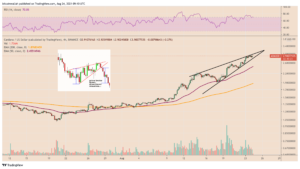Article by Sarbajit Biswas, Solutions Expert at LogiNext
Today, eCommerce has grown to be a massive and thriving industry that generates a lot of revenue. The rapid expansion of the eCommerce sector has had a significant impact on the market and logistics management. The success of eCommerce is entirely dependent on user responses, purchasing habits, and the brand’s logistics solution. This includes– better route planning and route optimization to deliver the orders faster and in the most cost and time-efficient manner. And especially for a category like Big & Bulky products which has seen a 300% rise since the pandemic. But there is a black diamond in the whole process, i.e. the reverse logistics.
Why a black diamond?
Black diamond is also known as Carbonado, is the toughest form of natural diamond, is precious but only a few people focus on it. The analogy here is, almost all of the eCommerce players who sell big and bulky items focus on the diamond i.e. quicker pick-ups and deliveries and most of them misses out on the black diamond which is one of the toughest processes as large-format items (furniture, air conditioners, refrigerators, etc.) have additional challenges due to the size and weight of the shipments, which necessitates extra personnel and specialized freight.
How important is reverse logistics from a brand’s perspective?

According to one of the reports of Consultancy ShipMatrix, in 2020 the market for online heavy-goods order delivery was $11.8 billion and is approximately growing at a rate of 18% year on year.
eCommerce brands strive to automate and optimize their logistics processes to enhance customer satisfaction because if the customers are satisfied then the brand value is preserved. The reverse logistics or the return process plays a very crucial role here, these days customers are not looking for quicker deliveries but also a quick and seamless return process (if required).
Customer retention and brand preservation are becoming increasingly dependent on the returns process. This is especially true in the online age, where customers are fickle and demanding and have no qualms about slamming a company on social media if they aren’t happy. If a return is needed, the process becomes their final impression, and are more likely to purchase goods from a brand if they believe returns are simple, and if they have a positive return experience, they are even more likely to become repeat customers. Home Depot, for example, provides reverse logistics assistance for online orders made through its website. In 2020, the company’s online sales accounted for about 15% of overall sales.
In short, the customer experience, which cannot be compromised, and the cost factor, which is a necessary evil that must be considered, are both key aspects of the Reverse Logistics life cycle. Now if we break this life cycle, even more, we will find multiple challenges that are acting as a bumper at each stage of this life cycle:
Stage 1: The extraction stage
The challenges here include allocating the right resource (fleet), tracking the reverse type orders, route planning based on the pickup location, scheduling the process, and proper communication to the customers
Stage 2: The dispatch stage
Once stage 1 is done, the next set of challenges include tracking the resources and orders in real-time, monitoring for any alerts, and visibility on the order lifecycle stages
Stage 3: The acquired stage
This is the stage when the reverse order is received at a distribution center/hub and the challenges here include forwarding the return orders to the right retailer’s location which involves debagging and bagging, sorting, return validation checks and verification of order and logging of information on order level
Stage 4: The forward stage
This is the stage where the orders are bagged and forwarded to the respective retailers/sellers (if not stored), the challenges here are the same as in stage 1.
How to handle these challenges?
Digitalization of the supply chain offers a huge potential to expedite returns management operations and eliminate inefficiencies in redundant processes. Digitalization can be used for almost any task, irrespective of its physical or virtual nature, and from a reverse logistics perspective, if we consider the lifecycle stages, a transport automation system would help in route planning which will help in minimizing the time, distance to reach the pickup location which in turn reduce the total cost, a fleet tracking solution to monitor and track the resources on a real-time basis, a dispatch software solution to efficiently dispatch the return order requests, a fleet management solutions to manage the fleet resources and the availability and the last mile delivery solution to help forward the return goods to the respective sellers
Final thoughts
With more heavy-goods deliveries, will come more heavy-goods returns, and now is the time that brands should focus on refining the black diamond (reverse logistics) by making the process more efficient, optimized and automated by using software like LogiNext Mile.
Like  Source: https://loginextsolutions.com/blog/handling-big-bulky-product-ecommorce/
Source: https://loginextsolutions.com/blog/handling-big-bulky-product-ecommorce/
- &
- 11
- 2020
- 7
- 9
- Additional
- All
- Automated
- Automation
- availability
- Billion
- Black
- brands
- Checks
- Communication
- company
- customer experience
- Customer satisfaction
- Customers
- Deliveries
- delivery
- Dispatch
- distance
- ecommerce
- etc
- expansion
- extraction
- FLEET
- fleet management
- Focus
- form
- Forward
- freight
- goods
- Growing
- here
- Home
- How
- HTTPS
- huge
- Impact
- industry
- information
- IT
- JavaScript
- Key
- last mile
- location
- logistics
- Making
- management
- Market
- Media
- monitoring
- Offers
- online
- online sales
- Operations
- order
- orders
- People
- Personnel
- perspective
- Pickup
- planning
- Product
- Products
- purchase
- real-time
- reduce
- Reports
- resource
- Resources
- returns
- revenue
- reverse
- Route
- sales
- seamless
- sell
- set
- Short
- Simple
- Size
- Social
- social media
- Software
- software solution
- Solutions
- Stage
- success
- supply
- supply chain
- system
- time
- track
- Tracking
- transport
- value
- Verification
- Virtual
- visibility
- W3
- Website
- WHO
- XML
- year









